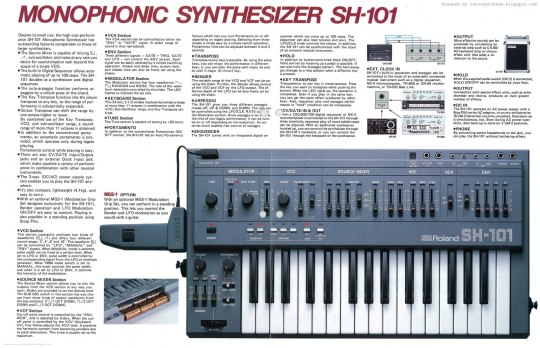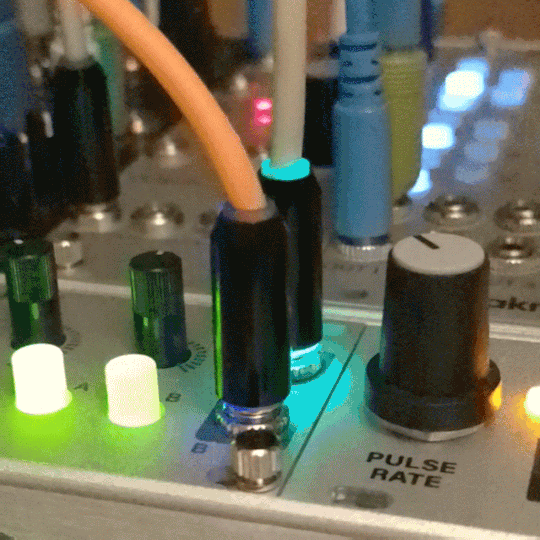#monosynth
Explore tagged Tumblr posts
Text

Roland SH-101
#Roland#sh-101#roland sh-101#analog synth#monosynth#keytar#VCO#VCF#VCA#envelope generator#arpeggio#sequencer#keyboard#1982
75 notes
·
View notes
Text
youtube
Radikal Technologies Spectralis 2 monosynth and Elektron Machinedrum
#synth#synthesizer#jam#session#radikaltechnologies#spectralis#monosynth#digitakt#elektron#drummachine#midera#Youtube
3 notes
·
View notes
Text
Nekobi ~ Single Oscillator Synth
Simple single-oscillator synth based on the Roland TB-303. github.com/DISTRHO/Nekobi A softsynth recreation of a classic single-oscillator bass monosynth. github.com/gordonjcp/nekobee

View On WordPress
0 notes
Text
Tuesday, November 27, 2018: Five years ago today, Corduroy Institute convened at the O' Higgins Laboratory of Recorded Sound to create Corduroy 19.
The piece centered around a rhythmic eight-step sequence on the Korg Monlogue, the first of only two instances of using that specific monosynth's unique sequencer. W. Ruiz sent the MIDI Out on the synthesizer to send clock data to control the timing of the Korg Electribe ES-1's drum pattern. S.A. Morin, meanwhile, played the Bass VI with the Boss LMB-2 bass compressor and the Boss DM-2w delay. These elements constituted the rhythmic foundation of the song.


For melodic content, W. Ruiz ran the Korg Volca FM through the Electribe ES-1 to add live decimator and delay effects, a technique previously explored on "Soft Light and Loneliness" from our second EP. At times the delay added an element which our journal classified as "reggae chords."

S.A. Morin also took the opportunity to use a guitar which has rarely featured on Corduroy Institute recordings: the Schecter Omen-6. Our notes indicate that this guitar was processed with the Boss TE-2 Tera Echo, Boss DC-3 Digital Dimension, NUX Atlantic, TC Electronic Crescendo and the Deadbeat Sound Thank You. Notably, however, this guitar was not in standard tuning—it was set to G# C# C# F B D#. The notes indicate that W. Ruiz also overdubbed some guitar work at the end of the piece, but this was not included in the final mix.

We then crafted lyrics for this improvised musical piece. It is notable to see how the cut-ups from the B. Davis Archive contain textual elements of varying sizes. This visually striking array of large and small text is unusual in our history, though a few songs from the forthcoming Take the Train to Manchester album did display this pattern.


We sang a rough set of vocals, but the final vocals would have to be completed on December 15, 2018, at the Bancroft Laboratory of Auditory Sciences. Corduroy 19 eventually became "Unfocused Subjects Fused," the third song on our mini-album Abruptly Forgetting We Never Were... from January 2019.
Today, we invite you to revisit this little-known catalog entry in our discography.
https://corduroyinstitute.bandcamp.com/album/abruptly-forgetting-we-never-were?t=3
https://youtu.be/j1EMwZ9LCeg?si=E4o55e0q782UuKtH
https://music.apple.com/us/album/unfocused-subjects-fused/1449236688?i=1449236693
https://tidal.com/browse/track/102250975
https://open.spotify.com/track/7xlX4RH7yfGooPrhX2hMRF
#CorduroyInstitute #experimentalpop #Corduroy19 #noisepop #shoegaze #dreampop #korgmonologue #alternatetunings #synthesizer #drummachine #ElectribeEs1 #volcaFM #BassVI #SchecterOmen6 #UnfocusedSubjectsFused #AbruptlyForgettingWeNeverWere
#corduroy institute#experimental pop#experimental music#independent music#corduroy 19#unfocused Subjects fused#abruptly forgetting we never were#bass VI#synthesizer#fm synthesizer#monosynth#sampler#electribe#schecter guitars
0 notes
Text


Michigan Synth Works MSW-810m // monosynth (US, 2022)
Roland CMU-810 clone
299 notes
·
View notes
Text

Deeper diving into animating the monosynth, and going from jam to song.
There's not a lot to say about this patch that hasn't been covered by other recent posts, in terms of signal flow. Milky way continues to impress me as a space effect for this smaller case, and Tete offers so many fascinating ways to play and sequence, really just a joy to play. Not every controller is a winner, but once you add something truly playable to the ecosystem, it changes the way you interact with and think about your instrument. I feel about it how I did when I brought in Constellation and Maestro. The three of them together I really think make the ideal core brain that can be be anywhere from programmable to performable.
#modular synth#eurorack#glitch#glitch music#experimental music#electronic music#my music#ambient#ambient music#chiptune#patch notes#gif#flashing gif#visual stim#artists on tumblr#sound design#sound art#idm#industrial#industrial music
15 notes
·
View notes
Text
Just having repeating loops really makes this stuff more music-like.
(I believe this is my homemade monosynth voice plus Brains/Plaits, run by Chaos/Marbles.)
1 note
·
View note
Text
It's almost July, which means I can think about my monthly toy budget and there's a *lot* of stuff I wanna make that I'm totally not going to have time for, so I really shouldn't get all the supplies at once
- power supply for case (the micronova is fine until I build up my power needs)
- sequencer (I still have a ton I can work on virtually and I don't even have anything to sequence*... or anything to drive it)
- clock (this one's actually furthest along conceptually, I think I only need a rotary encoder for it... but I don't have anything to clock)
- poorly defined DSP project (I am planning to order a teensy soon and start playing with it during summer vacations, will it probably be the prototyping platform for granular, reverb, delay/chorus, karplus-strong... etc)
- mixer + output (line and headphone outputs... possibly audio interface and/or recording too, yet another teensy project)
- I still need to finish the monosynth voice, the core of the DCO is mostly complete, but she needs tweaks and also input/output processing. Then I gotta do VCA, function generator, I really should do a filter or three at some point...
- also, my oscilloscope is being a brat, so let's throw that on the list too
(*I say nothing to sequence, but it would be crazy easy to incorporate a midi USB interface, also there's a lot of codependencies here, like I need x for y and y for x, I'm trying to serialize my workload to keep it mentally manageable, but there's sooooo much to do before I have a functional instrument)
4 notes
·
View notes
Text
fucked up that 3Oh!3 is named after an area code not the monosynth
4 notes
·
View notes
Text
Why the hell do I own a monosynth but no drum machine. It's ok though because I can turn it into an inferior drum machine anyway by sketchily repurposing its disparate oscillators. You will listen to my noise hi hat and sine kick and you will like it.
1 note
·
View note
Text
youtube
Tangerine Dream style 960 sequences on 5 Behringer mono synths
0 notes
Text

"True to the Moog legacy and innovative spirit of Dr. Robert Moog": Moog unveils new $899 analogue monosynth, Messenger https://www.musicradar.com/music-tech/synths/moog-unveils-new-analogue-monosynth-messenger?utm_source=dlvr.it&utm_content=other&utm_medium=tumblr
0 notes
Text
Moog Strikes Back with Messenger Synthesizer to Compete with Budget Clones

Source: rekkerd.org
Moog, the legendary name in analog synthesis, has unveiled its newest creation—the Moog Messenger, a compact monophonic analog synthesizer aimed at both honoring its rich heritage and pushing into a new era. This new model is designed to counter the rise of affordable clone synths that have flooded the market in recent years, offering users a genuine Moog experience at a more accessible price point.
The Messenger combines decades of analog expertise into a portable three-octave unit with 32 semi-weighted keys and a control-laden interface that invites real-time sonic exploration. With a focus on authentic analog sound design, the Messenger boasts a new array of filters and oscillators alongside classic circuitry, staying true to Moog’s iconic warmth and gritty texture.
Despite no longer being an all-American manufacturer—following its acquisition by inMusic and the shift of production facilities overseas—Moog aims to retain its soul with the Messenger, balancing heritage with innovation. Joe Richardson, President of Moog Music, described the instrument as “crafted for musicians and producers seeking a portable, powerful monosynth that delivers the iconic Moog sound.”
Built for Performance and Creativity
The Moog Messenger isn’t just about sound quality—it’s about hands-on performance. Unlike many modern synthesizers that rely on screens and complex menus, this new Moog model embraces simplicity. Each function has a dedicated knob or switch, allowing users to dive straight into sound sculpting without getting lost in submenus.
The synthesizer also comes loaded with 256 onboard presets, a 64-step sequencer, and a built-in arpeggiator with various patterns, giving users the tools to craft rhythmic and melodic patterns on the fly. The connectivity suite is equally impressive, featuring MIDI (both 5-pin and USB-C), control voltage (CV) inputs and outputs, and clock sync for integration with other gear.
Erik Norlander, Director of Keyboard Product Development at inMusic, noted that the Moog Messenger was designed to invite exploration. “Our goal was to create a synthesizer that welcomes first-time Moog players and offers the depth and expressiveness that experienced musicians expect,” he explained.
Balancing Legacy with Accessibility
Moog’s decision to move production to Asia has sparked some debate among fans who view the brand’s Asheville, North Carolina roots as integral to its identity. However, the shift is part of a larger strategy to remain competitive in a market saturated with low-cost clone synths. With devices mimicking Moog’s legendary Model D retailing for under $500, the company faced mounting pressure to create a high-quality yet affordable alternative.
The Messenger may prove to be Moog’s answer to this challenge—a genuine analog synth that bridges the gap between legacy craftsmanship and mass-market accessibility. While purists may lament the move from hand-built American instruments, the Messenger could extend Moog’s reach to a new generation of musicians, all without sacrificing the sonic character that made the brand iconic.
As Moog enters this new chapter, the Moog Messenger stands as both a defensive move against imitation and a bold step toward making analog synthesis more widely accessible.
0 notes
Text
u don't need a eurorack u need a basic monosynth and 5 fuzz pedals
1 note
·
View note
Text
youtube
Nord Drum 3p - A Six Part Mono Synth!
an interesting take on using the nord drum 3p as a monosynth
note: setup for this might be really tricky as the midi setup is pretty arcane if you're not on global channel 10
0 notes
Text

Traditional, decaying.
Learning the ropes of Magneto with a small dedicated monosynth - though I think I'll enjoy it even more when it's fully incorporated to my system. For now, we're very classic - VCO, VCF, VCA, delay, reverb, keyboard. Add in an arpeggiator and Planar for a little more expression and we're off to the races.
Pleasing, warm, especially melodic ambience here, with a little tape decay.
#modular synth#eurorack#glitch#glitch music#experimental music#electronic music#my music#ambient#ambient music#generative music#patch notes#gif#flashing gif#modular synthesis#sound design#idm#industrial#industrial music#make noise#visual stim
20 notes
·
View notes